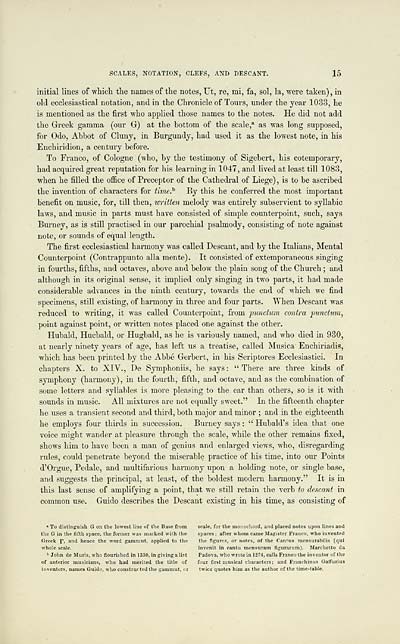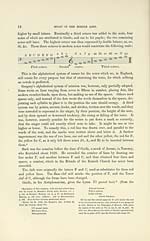Glen Collection of printed music > Printed text > Popular music of the olden time > Volume 1
(49) Page 15
Download files
Complete book:
Individual page:
Thumbnail gallery: Grid view | List view

SCALES, NOTATION, CLEFS, AND DESCANT. 15
initial lines of wMch the names of the notes, Ut, re, mi, fa, sol, la, were taken), in
old ecclesiastical notation, and in the Chronicle of Tours, under the year 1033, he
is mentioned as the first who applied those names to the notes. He did not add
the Greek gamma (our G) at the bottom of the scale," as was long supposed,
for Odo, Abbot of Cluny, in Burgundy, had used it as the lowest note, in his
Enchiridion, a century before.
To Franco, of Cologne (who, by the testimony of Sigebert, his cotemporary,
had acquired great reputation for his learning in 1047, and Uved at least till 1083,
when he filled the office of Preceptor of the Cathedral of Liege), is to be ascribed
the invention of characters for timey By this he conferred the most important
benefit on music, for, till then, written melody was entirely subservient to syllabic
laws, and music in parts must have consisted of simple counterpoint, such, says
Bui-ney, as is still practised in our parochial psalmody, consisting of note against
note, or sounds of equal length.
The first ecclesiastical harmony was called Descant, and by the Italians, Mental
Counterpoint (Contrappunto alia mente). It consisted of extemporaneous singing
in foui-ths, fifths, and octaves, above and below the plain song of the Church ; and
although in its original sense, it implied only singing in two parts, it had made
considerable advances in the ninth century, towards the end of which we find
specimens, still existing, of harmony in three and four parts. When Descant was
reduced to wi'iting, it was called Counterpoint, from punctum contra punctum,
point against point, or written notes placed one against the other.
Hubald, Hucbald, or Hugbald, as he is variously named, and who died in 930,
at nearly ninety years of age, has left us a treatise, called Musica Enchiriadis,
which has been printed by the Abbe Gerbert, in his Scriptores Ecclesiastici. In
chapters X. to XIV., De Symphoniis, he says: "There are three kinds of
symphony (harmony) , in the fourth, fifth, and octave, and as the combination of
some letters and syllables is more pleasing to the ear than others, so is it with
sounds in music. All mixtures are not equally sweet." In the fifteenth chapter
he uses a transient second and third, both major and minor ; and in the eighteenth
he employs four thirds in succession. Burney says : " Hubald' s idea that one
voice might wander at pleasure through the scale, while the other remains fixed,
shows him to have been a man of genius and enlarged views, who, disregarding
rules, could penetrate beyond the miserable practice of his time, into our Points
d'Orgue, Pedale, and multifarious harmony upon a holding note, or single base,
and suggests the principal, at least, of the boldest modern harmony." It is in
this last sense of amplifying a point, that we still retain the verb to descant in
common use. Guide describes the Descant existing in his time, as consisting of
■^ To distinguish G on the lowest line of the Base from scale, for the raoiiochord, and placed notes upon lines and
the G in the fifth space, the former was marked with the spaces ; after whom came Magister Franco, who invented
Greek r, and hence the word garamut, applied to the the figures, or notes, of the Cantus mensurabilis (qui
whole scale. invenit in cantu mensuram figurarum). Marchetto da
*■ John de Muris, who flourished in 1330, in giving a list Padova, who wrote in 1274, calls Franco the inventor of the
of anterior musicians, who had merited tlie title of four first musical characters: and Franchinus Gafl^urius
inventors, names Guido, who construf ted the gammut, or twice quotes him as the author of the time-table.
initial lines of wMch the names of the notes, Ut, re, mi, fa, sol, la, were taken), in
old ecclesiastical notation, and in the Chronicle of Tours, under the year 1033, he
is mentioned as the first who applied those names to the notes. He did not add
the Greek gamma (our G) at the bottom of the scale," as was long supposed,
for Odo, Abbot of Cluny, in Burgundy, had used it as the lowest note, in his
Enchiridion, a century before.
To Franco, of Cologne (who, by the testimony of Sigebert, his cotemporary,
had acquired great reputation for his learning in 1047, and Uved at least till 1083,
when he filled the office of Preceptor of the Cathedral of Liege), is to be ascribed
the invention of characters for timey By this he conferred the most important
benefit on music, for, till then, written melody was entirely subservient to syllabic
laws, and music in parts must have consisted of simple counterpoint, such, says
Bui-ney, as is still practised in our parochial psalmody, consisting of note against
note, or sounds of equal length.
The first ecclesiastical harmony was called Descant, and by the Italians, Mental
Counterpoint (Contrappunto alia mente). It consisted of extemporaneous singing
in foui-ths, fifths, and octaves, above and below the plain song of the Church ; and
although in its original sense, it implied only singing in two parts, it had made
considerable advances in the ninth century, towards the end of which we find
specimens, still existing, of harmony in three and four parts. When Descant was
reduced to wi'iting, it was called Counterpoint, from punctum contra punctum,
point against point, or written notes placed one against the other.
Hubald, Hucbald, or Hugbald, as he is variously named, and who died in 930,
at nearly ninety years of age, has left us a treatise, called Musica Enchiriadis,
which has been printed by the Abbe Gerbert, in his Scriptores Ecclesiastici. In
chapters X. to XIV., De Symphoniis, he says: "There are three kinds of
symphony (harmony) , in the fourth, fifth, and octave, and as the combination of
some letters and syllables is more pleasing to the ear than others, so is it with
sounds in music. All mixtures are not equally sweet." In the fifteenth chapter
he uses a transient second and third, both major and minor ; and in the eighteenth
he employs four thirds in succession. Burney says : " Hubald' s idea that one
voice might wander at pleasure through the scale, while the other remains fixed,
shows him to have been a man of genius and enlarged views, who, disregarding
rules, could penetrate beyond the miserable practice of his time, into our Points
d'Orgue, Pedale, and multifarious harmony upon a holding note, or single base,
and suggests the principal, at least, of the boldest modern harmony." It is in
this last sense of amplifying a point, that we still retain the verb to descant in
common use. Guide describes the Descant existing in his time, as consisting of
■^ To distinguish G on the lowest line of the Base from scale, for the raoiiochord, and placed notes upon lines and
the G in the fifth space, the former was marked with the spaces ; after whom came Magister Franco, who invented
Greek r, and hence the word garamut, applied to the the figures, or notes, of the Cantus mensurabilis (qui
whole scale. invenit in cantu mensuram figurarum). Marchetto da
*■ John de Muris, who flourished in 1330, in giving a list Padova, who wrote in 1274, calls Franco the inventor of the
of anterior musicians, who had merited tlie title of four first musical characters: and Franchinus Gafl^urius
inventors, names Guido, who construf ted the gammut, or twice quotes him as the author of the time-table.
Set display mode to: Large image | Transcription
Images and transcriptions on this page, including medium image downloads, may be used under the Creative Commons Attribution 4.0 International Licence unless otherwise stated. ![]()
| Special collections of printed music > Glen Collection of printed music > Printed text > Popular music of the olden time > Volume 1 > (49) Page 15 |
|---|
| Permanent URL | https://digital.nls.uk/91368035 |
|---|
| Shelfmark | Glen.254 |
|---|---|
| Additional NLS resources: | |
| Attribution and copyright: |
|
| Description | Scottish songs and music of the 18th and early 19th centuries, including music for the Highland bagpipe. These are selected items from the collection of John Glen (1833 to 1904). Also includes a few manuscripts, some treatises, and other books on the subject. |
|---|
| Description | The Glen Collection and the Inglis Collection represent mainly 18th and 19th century Scottish music, including Scottish songs. The collections of Berlioz and Verdi collected by bibliographer Cecil Hopkinson contain contemporary and later editions of the works of the two composers Berlioz and Verdi. |
|---|

